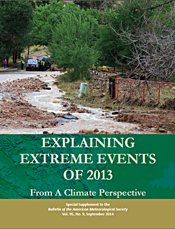 In my post at The Daily Blog this week I take inspiration from the great Ian Dury, and reflect on the disconnect between political ambition and the state of the climate system as it continues to warm. It will be my last post at TDB for a while – for definitions of “a while” that include the time to write a book, refocus on Hot Topic, prepare the farm for the drought I fear we’re heading towards, and (with luck) harvest lots of truffles and make some damn fine wine…
In my post at The Daily Blog this week I take inspiration from the great Ian Dury, and reflect on the disconnect between political ambition and the state of the climate system as it continues to warm. It will be my last post at TDB for a while – for definitions of “a while” that include the time to write a book, refocus on Hot Topic, prepare the farm for the drought I fear we’re heading towards, and (with luck) harvest lots of truffles and make some damn fine wine…
Author: Gareth
Carbon News 20/10/14: Chile’s carbon tax, soil SOS and more pressure on dirty investments
Chile’s new tax could open carbon doors for NZ
Chile’s new carbon tax potentially offers New Zealand an opportunity to offset some of its own agricultural greenhouse gas emissions, says economist Dr Suzi Kerr. The $US5-a-tonne carbon tax slipped into Chilean law last month as part of a package of tax reforms.
Soils SOS as cities gobble up our best growing land
New Zealand is allowing its elite soils to be eaten up by cities — despite signing up to a new global campaign to protect valuable agricultural land. New Zealand launched its membership of the 17-country Pacific Soil Partnership on Wednesday – the same day that the Government announced it would push ahead with plans to ease planning rules to allow our cities to spread.
Rod Oram: Why i’m getting out of fossil fuels
Business commentator Rod Oram is putting his money where his mouth is when it comes to sustainable investment. Like the Rockefellers in the United States, Oram has ditched his fossil fuel investments.
Kiwi savers want investments to do clean work
A survey of New Zealanders has revealed that Kiwis care deeply about how their KiwiSaver funds are being invested and that they want more sustainable KiwiSaver options. Continue reading “Carbon News 20/10/14: Chile’s carbon tax, soil SOS and more pressure on dirty investments”
Salinger: New Zealand is drying out, and here’s why
In this guest post Jim Salinger (currently working in Italy, but soon to return to these shores), takes a look at the climate influences on last year’s severe New Zealand drought. It first appeared on The Conversation.
 Over 2012 and 2013, parts of New Zealand experienced their worst drought in nearly 70 years. Drought is the costliest climate extreme in New Zealand; the 2012-2013 event depressed the country’s GDP by 0.7-0.9%. The drought of 1988-1989 affected 5,500 farms, pushing some farmers to the wall. But what does a climate-changed future hold?
Over 2012 and 2013, parts of New Zealand experienced their worst drought in nearly 70 years. Drought is the costliest climate extreme in New Zealand; the 2012-2013 event depressed the country’s GDP by 0.7-0.9%. The drought of 1988-1989 affected 5,500 farms, pushing some farmers to the wall. But what does a climate-changed future hold?
Recent evidence confirms that New Zealand on the whole is getting dryer. And we’re beginning to understand why — increasing greenhouse and ozone-depleting gases are driving changes in the atmosphere, with impacts far beyond New Zealand.
Continue reading “Salinger: New Zealand is drying out, and here’s why”
Carbon News 13/10/14: foresters in firing line
Anxious foresters await review of foreign credits ban
A controversial decision to make foresters the only emitters banned from using cheap foreign carbon credits to offset their greenhouse gas emissions is under review. The provision was slipped through without warning as part of the Government’s Budget in May, and came into effect immediately.
Business poser: are you creating value, or destroying it?
New Zealand is leading the world on integrated reporting but our business leaders are still not taking it seriously enough, latest data shows.
Beehive stays silent on emissions target
The Government remains mum on New Zealand’s 2030 emissions reduction target. New Zealand did not make any mention of its 2030 target at last month’s Climate Summit in New York, at which United Nations Secretary General Ban Ki-moon asked world leaders to give an indication of the commitments they would make at international climate change negotiations in Paris in December.
New Zealand is drying out … and here’s why
Over 2012 and 2013, parts of New Zealand experienced their worst drought in nearly 70 years. Continue reading “Carbon News 13/10/14: foresters in firing line”
Extremes report 2013: NZ drought and record Aussie heat made worse by warming
 The latest climate extremes report finds that 9 out of 16 extreme weather events from last year were influenced by climate change. In particular, the conditions that led to New Zealand’s severe North Island drought — the worst for 41 years, estimated to have cost the economy NZ$1.3 billion — were made more likely by the effects of continued warming. Australia’s hottest ever year and run of record-breaking heatwaves also had humanity’s fingerprints all over it. The new research — Explaining Extreme Events of 2013 from a Climate Perspective [pdf] — published as a special edition of the Bulletin of the American Meteorological Society, is the latest in a series of reports designed to look at weather extremes soon after they happen, and look for signs of the influence of climate change.
The latest climate extremes report finds that 9 out of 16 extreme weather events from last year were influenced by climate change. In particular, the conditions that led to New Zealand’s severe North Island drought — the worst for 41 years, estimated to have cost the economy NZ$1.3 billion — were made more likely by the effects of continued warming. Australia’s hottest ever year and run of record-breaking heatwaves also had humanity’s fingerprints all over it. The new research — Explaining Extreme Events of 2013 from a Climate Perspective [pdf] — published as a special edition of the Bulletin of the American Meteorological Society, is the latest in a series of reports designed to look at weather extremes soon after they happen, and look for signs of the influence of climate change.
The NZ paper, The role of anthropogenic climate change in the 2013 drought over North Island, New Zealand by Luke Harrington, Suzanne Rosier, Sam M. Dean, Stephen Stuart, and Alice Scahill (page s45 in the pdf), finds that a long term trend towards increasing summer high pressure systems over the North Island — seen in climate models as the system warms — has increased the risk of drought substantially.
No fewer than 5 studies in the new report found clear links between Australia’s record-breaking 2013 heat and the influence of human-induced warming, as explained by The Conversation here.
Climate change is already increasing the likelihood of heatwaves occurring in Australia and the temperatures we experience during these heatwaves. Extremely hot months, seasons and years are already more likely in Australia.
This human handprint will likely increase the future risk of extremely warm days, months, season and years in Australia. We will likely also see an increase in the risk of heatwaves and dry conditions acting in combination with heat to produce drought.
A summary of the report’s contents is available from NOAA, Climate Central has a very nice timeline, and The Guardian does it with pictures. Strangely, given the subject matter, only TV3 picked up on the NZ drought link (basing their story on a press release from the Green Party), while the NZ Herald chose to run an AFP story that led with the Aussie heatwaves and only mentioned the NZ drought in passing. Neither NIWA nor VUW chose to issue press releases about the study, despite its obvious newsworthiness and relevance to the NZ agricultural community.
[Update 2/10: Stuff.co.nz finally covers the story, with quotes from NIWA’s Sam Dean.]
